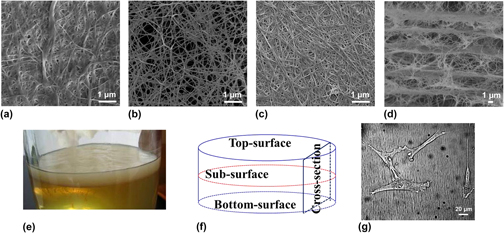Crossref Citations
This article has been cited by the following publications. This list is generated based on data provided by
Crossref.
Yassine, Fatima
Bassil, Nathalie
Chokr, Ali
El Samrani, Antoine
Serghei, Anatoli
Boiteux, Gisèle
and
El Tahchi, Mario
2016.
Two-step formation mechanism of Acetobacter cellulosic biofilm: synthesis of sparse and compact cellulose.
Cellulose,
Vol. 23,
Issue. 2,
p.
1087.
Yassine, Fatima
Bassil, Nathalie
Flouty, Roula
Chokr, Ali
Samrani, Antoine El
Boiteux, Gisèle
and
Tahchi, Mario El
2016.
Culture medium pH influence on Gluconacetobacter physiology: Cellulose production rate and yield enhancement in presence of multiple carbon sources.
Carbohydrate Polymers,
Vol. 146,
Issue. ,
p.
282.
Hu, Yang
Zhu, Yongjun
Zhou, Xin
Ruan, Changshun
Pan, Haobo
and
Catchmark, Jeffrey M.
2016.
Bioabsorbable cellulose composites prepared by an improved mineral-binding process for bone defect repair.
Journal of Materials Chemistry B,
Vol. 4,
Issue. 7,
p.
1235.
Hu, Yang
Li, Shanshan
Jackson, Tanya
Moussa, Hanna
and
Abidi, Noureddine
2016.
Preparation, Characterization, and Cationic Functionalization of Cellulose-Based Aerogels for Wastewater Clarification.
Journal of Materials,
Vol. 2016,
Issue. ,
p.
1.
Ruan, Changshun
Zhu, Yongjun
Zhou, Xin
Abidi, Noureddine
Hu, Yang
and
Catchmark, Jeffrey M.
2016.
Effect of cellulose crystallinity on bacterial cellulose assembly.
Cellulose,
Vol. 23,
Issue. 6,
p.
3417.
Vasconcelos, Niédja Fittipaldi
Feitosa, Judith Pessoa Andrade
da Gama, Francisco Miguel Portela
Morais, João Paulo Saraiva
Andrade, Fábia Karine
de Souza Filho, Men de Sá Moreira
and
Rosa, Morsyleide de Freitas
2017.
Bacterial cellulose nanocrystals produced under different hydrolysis conditions: Properties and morphological features.
Carbohydrate Polymers,
Vol. 155,
Issue. ,
p.
425.
Li, Yi-Tsen
Lin, Shih-Bin
Chen, Li-Chen
and
Chen, Hui-Huang
2017.
Antimicrobial activity and controlled release of nanosilvers in bacterial cellulose composites films incorporated with montmorillonites.
Cellulose,
Vol. 24,
Issue. 11,
p.
4871.
Hu, Yang
Thalangamaarachchige, Vidura D.
Acharya, Sanjit
and
Abidi, Noureddine
2018.
Role of low-concentration acetic acid in promoting cellulose dissolution.
Cellulose,
Vol. 25,
Issue. 8,
p.
4389.
Acharya, Sanjit
Hu, Yang
and
Abidi, Noureddine
2018.
Mild condition dissolution of high molecular weight cotton cellulose in 1‐butyl‐3‐methylimidazolium acetate/N,N‐dimethylacetamide solvent system.
Journal of Applied Polymer Science,
Vol. 135,
Issue. 9,
Chen, Si-Qian
Lopez-Sanchez, Patricia
Wang, Dongjie
Mikkelsen, Deirdre
and
Gidley, Michael J.
2018.
Mechanical properties of bacterial cellulose synthesised by diverse strains of the genus Komagataeibacter.
Food Hydrocolloids,
Vol. 81,
Issue. ,
p.
87.
Wardhono, Endarto
Wahyudi, Hadi
Agustina, Sri
Oudet, François
Pinem, Mekro
Clausse, Danièle
Saleh, Khashayar
and
Guénin, Erwann
2018.
Ultrasonic Irradiation Coupled with Microwave Treatment for Eco-friendly Process of Isolating Bacterial Cellulose Nanocrystals.
Nanomaterials,
Vol. 8,
Issue. 10,
p.
859.
Wang, Jing
Zhao, Li
Zhang, Aixia
Huang, Yuan
Tavakoli, Javad
and
Tang, Youhong
2018.
Novel Bacterial Cellulose/Gelatin Hydrogels as 3D Scaffolds for Tumor Cell Culture.
Polymers,
Vol. 10,
Issue. 6,
p.
581.
Hu, Yang
Dassanayake, Rohan S.
Acharya, Sanjit
and
Abidi, Noureddine
2018.
Cellulose-Based Superabsorbent Hydrogels.
p.
1.
Cai, Qingqing
Hu, Chengbo
Yang, Na
Wang, Qingshan
Wang, Jianying
Pan, Haobo
Hu, Yang
and
Ruan, Changshun
2018.
Enhanced activity and stability of industrial lipases immobilized onto spherelike bacterial cellulose.
International Journal of Biological Macromolecules,
Vol. 109,
Issue. ,
p.
1174.
Drozd, Radosław
Rakoczy, Rafał
Wasak, Agata
Junka, Adam
and
Fijałkowski, Karol
2018.
The application of magnetically modified bacterial cellulose for immobilization of laccase.
International Journal of Biological Macromolecules,
Vol. 108,
Issue. ,
p.
462.
Hu, Yang
Liu, Haiyan
Zhou, Xin
Pan, Haobo
Wu, Xiuping
Abidi, Noureddine
Zhu, Yongjun
and
Wang, Jinhui
2019.
Surface engineering of spongy bacterial cellulose via constructing crossed groove/column micropattern by low-energy CO2 laser photolithography toward scar-free wound healing.
Materials Science and Engineering: C,
Vol. 99,
Issue. ,
p.
333.
S. Dassanayake, Rohan
Acharya, Sanjit
and
Abidi, Noureddine
2019.
Advanced Sorption Process Applications.
Portela, Raquel
Leal, Catarina R.
Almeida, Pedro L.
and
Sobral, Rita G.
2019.
Bacterial cellulose: a versatile biopolymer for wound dressing applications.
Microbial Biotechnology,
Vol. 12,
Issue. 4,
p.
586.
Hu, Yang
Acharya, Sanjit
and
Abidi, Noureddine
2019.
Cellulose porosity improves its dissolution by facilitating solvent diffusion.
International Journal of Biological Macromolecules,
Vol. 123,
Issue. ,
p.
1289.
Hu, Yang
Dassanayake, Rohan S.
Acharya, Sanjit
and
Abidi, Noureddine
2019.
Cellulose-Based Superabsorbent Hydrogels.
p.
331.





